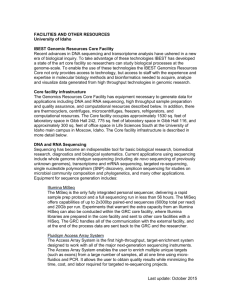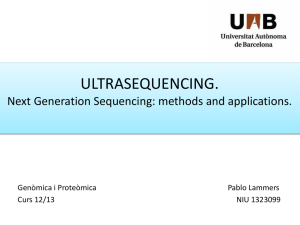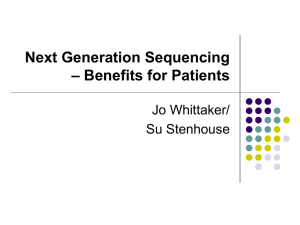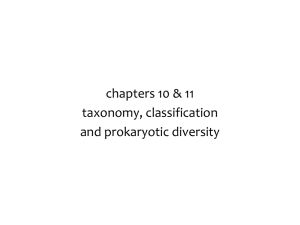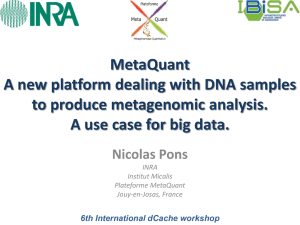Word - Deep Carbon Observatory
advertisement
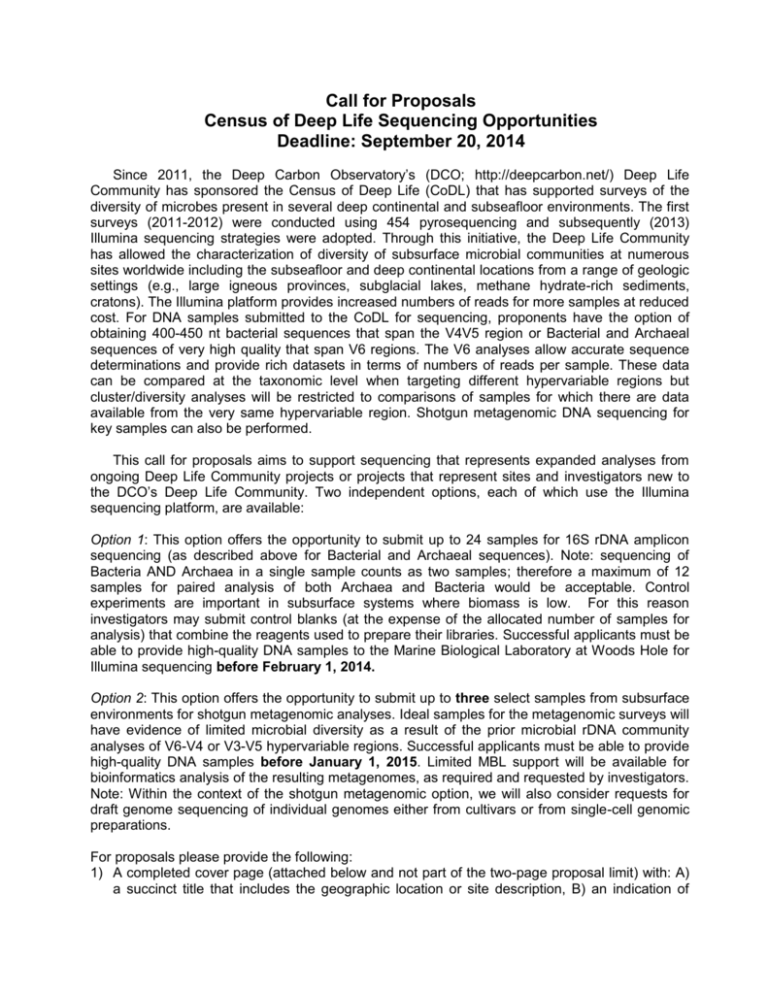
Call for Proposals Census of Deep Life Sequencing Opportunities Deadline: September 20, 2014 Since 2011, the Deep Carbon Observatory’s (DCO; http://deepcarbon.net/) Deep Life Community has sponsored the Census of Deep Life (CoDL) that has supported surveys of the diversity of microbes present in several deep continental and subseafloor environments. The first surveys (2011-2012) were conducted using 454 pyrosequencing and subsequently (2013) Illumina sequencing strategies were adopted. Through this initiative, the Deep Life Community has allowed the characterization of diversity of subsurface microbial communities at numerous sites worldwide including the subseafloor and deep continental locations from a range of geologic settings (e.g., large igneous provinces, subglacial lakes, methane hydrate-rich sediments, cratons). The Illumina platform provides increased numbers of reads for more samples at reduced cost. For DNA samples submitted to the CoDL for sequencing, proponents have the option of obtaining 400-450 nt bacterial sequences that span the V4V5 region or Bacterial and Archaeal sequences of very high quality that span V6 regions. The V6 analyses allow accurate sequence determinations and provide rich datasets in terms of numbers of reads per sample. These data can be compared at the taxonomic level when targeting different hypervariable regions but cluster/diversity analyses will be restricted to comparisons of samples for which there are data available from the very same hypervariable region. Shotgun metagenomic DNA sequencing for key samples can also be performed. This call for proposals aims to support sequencing that represents expanded analyses from ongoing Deep Life Community projects or projects that represent sites and investigators new to the DCO’s Deep Life Community. Two independent options, each of which use the Illumina sequencing platform, are available: Option 1: This option offers the opportunity to submit up to 24 samples for 16S rDNA amplicon sequencing (as described above for Bacterial and Archaeal sequences). Note: sequencing of Bacteria AND Archaea in a single sample counts as two samples; therefore a maximum of 12 samples for paired analysis of both Archaea and Bacteria would be acceptable. Control experiments are important in subsurface systems where biomass is low. For this reason investigators may submit control blanks (at the expense of the allocated number of samples for analysis) that combine the reagents used to prepare their libraries. Successful applicants must be able to provide high-quality DNA samples to the Marine Biological Laboratory at Woods Hole for Illumina sequencing before February 1, 2014. Option 2: This option offers the opportunity to submit up to three select samples from subsurface environments for shotgun metagenomic analyses. Ideal samples for the metagenomic surveys will have evidence of limited microbial diversity as a result of the prior microbial rDNA community analyses of V6-V4 or V3-V5 hypervariable regions. Successful applicants must be able to provide high-quality DNA samples before January 1, 2015. Limited MBL support will be available for bioinformatics analysis of the resulting metagenomes, as required and requested by investigators. Note: Within the context of the shotgun metagenomic option, we will also consider requests for draft genome sequencing of individual genomes either from cultivars or from single-cell genomic preparations. For proposals please provide the following: 1) A completed cover page (attached below and not part of the two-page proposal limit) with: A) a succinct title that includes the geographic location or site description, B) an indication of whether the proposed sequencing is for Option 1 or 2; C) name, address, e-mail address, phone number of investigators; and D) a brief abstract that includes the project objective. 2) The proposal within a two-page limit that includes: - Statement of the question(s) to be addressed by the sequencing opportunity. - A statement about which samples would be selected, the status of those samples (How were they/will they be collected? DNA extracted already?), and the availability, concentration, and quantity of DNA, and access to reference genomes for data analysis, if appropriate. - DNA extraction protocols including details about sample acquisition and evidence that the samples are representative of a subsurface setting. As noted above, the inclusion of a procedural and/or extraction blank is encouraged as a way to identify the inadvertent inclusion of contaminant sequences in datasets generated from exceedingly low biomass samples common to the subsurface. - Information about pre-existing biological diversity and metadata that describes abiological properties of the samples including site coordinates, sampling depth(s), date and time samples were collected or details on how these will be collected, and other relevant sample properties such as temperature, pH, alkalinity, etc. - Proposed experimental and data analysis plan including whether you will require assistance for metagenome assembly (for Option 2). - A brief timeline for the study with assurance for sending the DNA samples before February 1 2015 for metagenomic sequencing (Option 2) or before January 1 2015 for amplicon sequencing (Option 1). 3) A 2-page NSF-style biosketch for each of the primary investigators for the proposed project. Additional considerations: Successful proposals are posted on the CoDL website and are available to the public. We do not encourage submission of cDNA for sequencing. However, if clean cDNA preparations that are readily amplifiable are provided to MBL they will be run with no guarantee of success. Access to the sequence data will be possible for the PI once metadata for the samples have been entered into MBL’s VAMPS database. Successful applicants must agree to submit their sequence data and all relevant metadata to the public domain immediately upon acceptance of a manuscript but no later than 6 months after completion of the DNA sequencing phase. PIs may submit separate proposals to each option but they must indicate which proposal (Option 1 or 2) is their priority. Proposals should follow the format employed for prior submissions to the CoDL (see “Project Pages” at http://codl.coas.oregonstate.edu/main/documents.shtml). Please send proposals in Word format to: deeplife@coas.oregonstate.edu Reviews should be complete by mid-October 2014. Census of Deep Life Cover Sheet Project Information Project title (with geographic location or nature of deep subsurface site): Option 1 _____ Option 2 _____ Latitude/longitude _________________________ Principal Investigator Name: Address: phone #: e-mail: Co-Investigator Name: Address: phone #: e-mail: Co-Investigator Name: Address: phone #: e-mail: Brief project abstract with statement of objective
